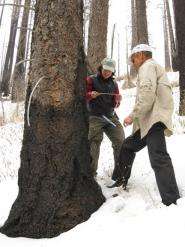Snowpack declines in Rockies unusual compared to past

(PhysOrg.com) -- The researchers evaluated the recent declines using snowpack reconstructions from 66 tree-ring chronologies, looking back 500 to more than 1,000 years.
The reduction in snowpack in the Rocky Mountains over the last 30 years is unusual compared to the past few centuries, according to a new study that includes University of Arizona researchers.
Previous studies attribute the decline to unusual springtime warming, more precipitation falling now as rain rather than snow and earlier snowmelt.
The warming and snowpack decline are projected to worsen through the 21st century, foreshadowing a strain on water supplies. Runoff from winter snowpack – layers of snow that accumulate at high altitude – accounts for 60 to 80 percent of the annual water supply for more than 70 million people living in the western U.S.
U.S. Geological Survey scientists, with partners at the UA, University of Washington, University of Wyoming and University of Western Ontario, led the study.
"We were interested in seeing how snowpack varied in three watersheds," said co-author Connie A. Woodhouse, UA associate professor of geography and regional development. "One in the northern Rockies that is the headwaters of the Columbia, one in Yellowstone that is the headwaters of the Missouri and one for Colorado that includes the headwaters of the Colorado."
Secretary of the Interior Ken Salazar said, "This scientific work is critical to understanding how climate change is affecting western water supplies. It helps land managers adapt to changing conditions on the ground, assists water managers with planning for the future, and gives all of us a better understanding of the real impacts that carbon pollution is having on our resources and our way of life."

The researchers evaluated the recent declines using snowpack reconstructions from 66 tree-ring chronologies, looking back 500 to more than 1,000 years. The network of sites was chosen strategically to characterize the range of natural snowpack variability over the long term, and from north to south in the Rocky Mountains.
With a few exceptions (the mid-14th and early 15th centuries), the snowpack reconstructions show that the northern Rocky Mountains experience large snowpacks when the southern Rockies experience meager ones, and vice versa. Since the 1980s, however, there were simultaneous declines along the entire length of the Rocky Mountains, and unusually severe declines in the north.
"Over most of the 20th century, and especially since the 1980s, the northern Rockies have borne the brunt of the snowpack losses," said USGS scientist Gregory Pederson, the lead author of the study.
"Most of the land and snow in the northern Rockies sits at lower and warmer elevations than the southern Rockies, making the snowpack more sensitive to seemingly small increases in temperature. Also, winter storm tracks were displaced to the south in the early 20th century and post-1980s. Forest fires were larger, more frequent and harder to fight, while Glacier National Park lost 125 of its 150 glaciers."
Pederson conducted part of the research at the UA's Laboratory for Tree-Ring Research. He earned his doctorate from the UA's School of Natural Resources and the Environment in 2010.
USGS scientist and co-author Julio Betancourt said, "The difference in snowpack along the north and south changed in the 1980s, as the unprecedented warming in the springtime began to overwhelm the precipitation effect, causing snowpack to decline simultaneously in the north and south. Throughout the West, springtime tends to be warmer during El Niño than La Niña years, but the warming prior to the 1980s was usually not enough to offset the strong influence of precipitation on snowpack."
The La Niña episode this year is an example with lots of snow in the north while severe drought afflicts the south. But, in the north, this year's gains are only a small blip on a century-long snowpack decline.
In the West, the average position of the winter storm tracks tend to fluctuate north and south around a latitudinal line connecting Denver, Salt Lake City and Sacramento. In El Niño years, winter storms track south of that line, while in La Niña years, they track to the north.
This study supports research by others estimating that between 30-60 percent of the declines in the late 20th century are likely due to greenhouse gas emissions. The remaining part of the trend can be attributed to natural decadal variability in the ocean and atmosphere, which is making springtime temperatures that much warmer.
Pederson said, "What we have seen in the last few decades may signal a fundamental shift from precipitation to temperature as the dominant influence on western snowpack."
The study, "The unusual nature of recent snowpack declines in the North American Cordillera," is available from Science magazine online.
Provided by University of Arizona


















